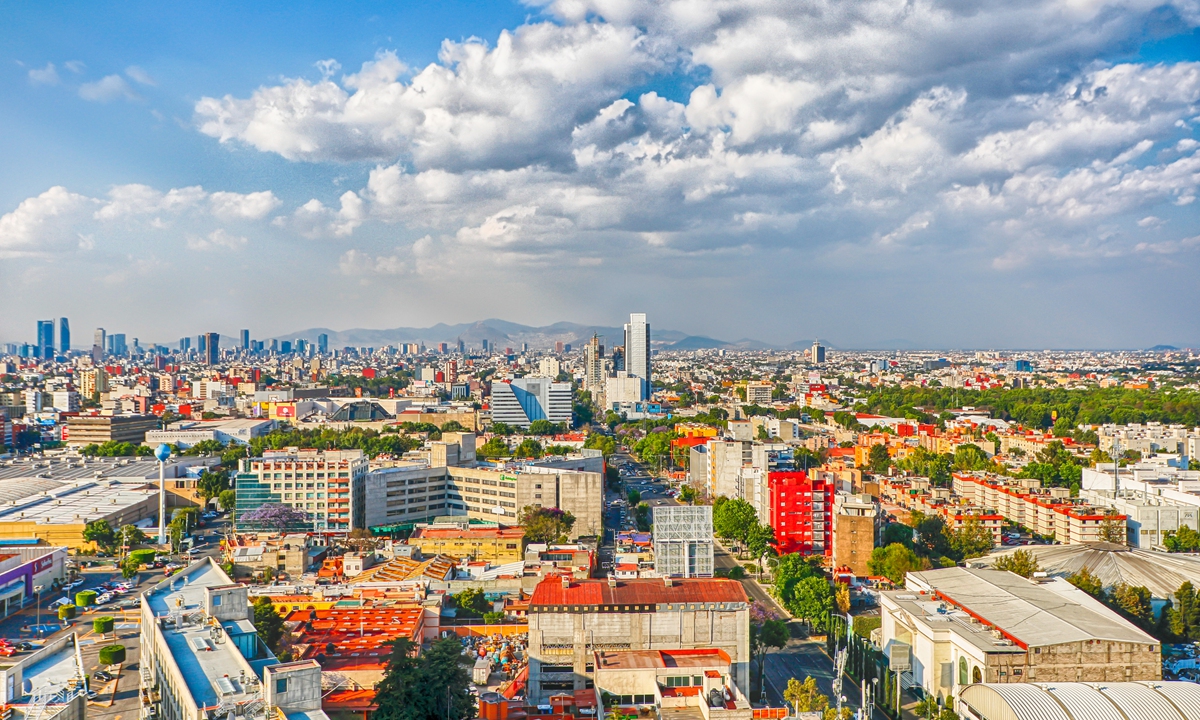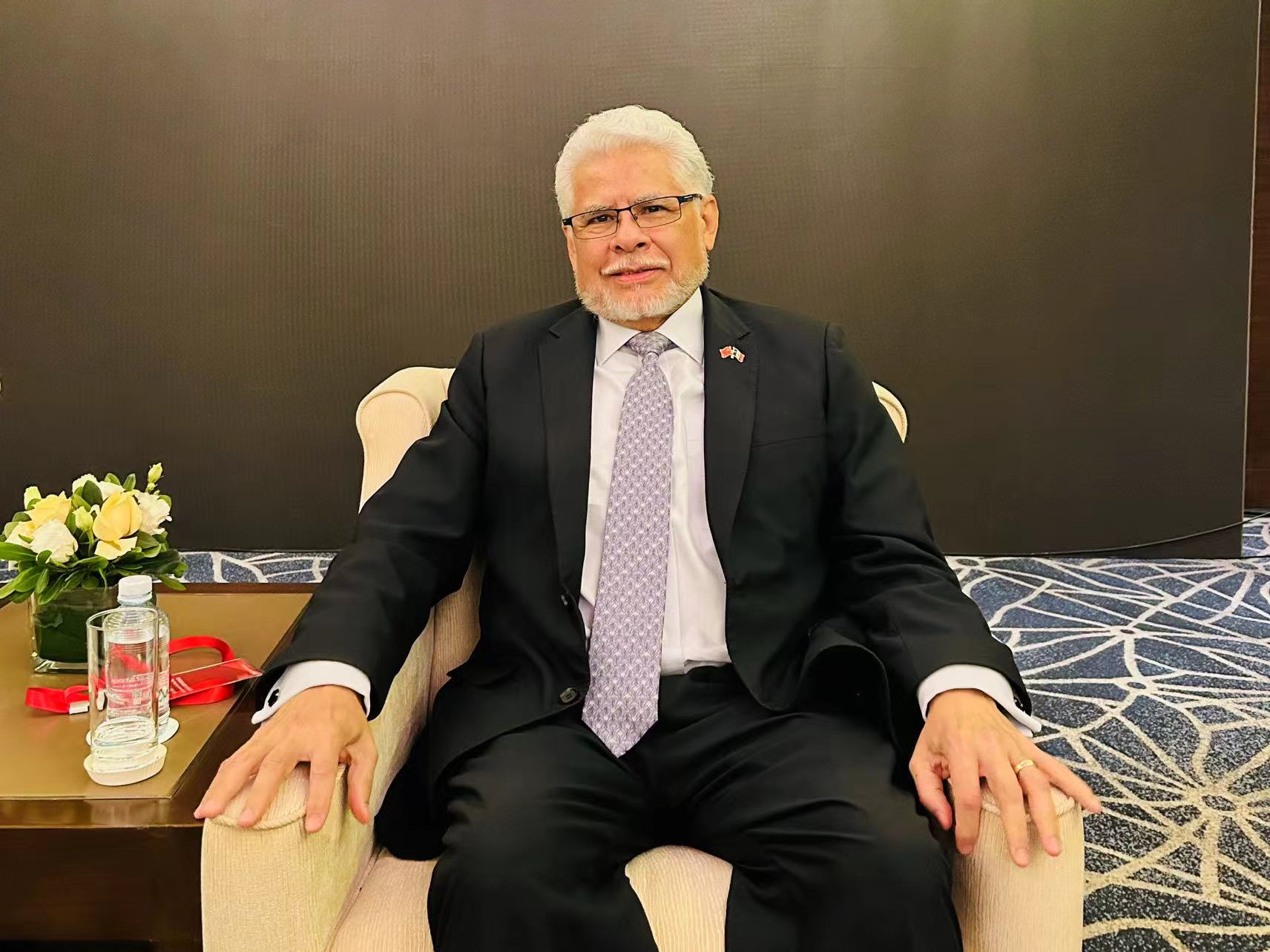
The view of Mexico City Photo: VCG
Editor's Note:
Despite an increasingly complex global trade landscape, China and Mexico have actively promoted pragmatic economic and trade cooperation across various sectors in recent years. During the Eighth Global Think Tank Summit, hosted by the China Center for International Economic Exchanges, Global Times reporter Ma Tong (
GT) interviewed José Luis Bernal (
Bernal), former Mexican Ambassador to China. Bernal highlighted the significant achievements and vast potential of the China-Mexico economic operation in recent years and expressed confidence in China's economic growth in the coming years.
GT: Drawing on your expertise in observing China-Mexico economic and trade relations, what are the highlights and achievements of the bilateral ties in recent years?
Bernal: Over the past 20 years, Mexico and China have consistently promoted new agreements to enhance mainly economic relations. We have maintained a very good political dialogue and cooperation in various fields. This continuous growth trend started in 2003 when we established our first strategic partnership. In 2013, Mexico and China relations evolved into a comprehensive strategic partnership.
Since then, we have established new dialogue and cooperation mechanisms with the most focus on the economic sectors, including trade, investment, and finance, representing a crucial communication chapter between businesses from both countries. This constitutes a part of the globally-established institutional framework that facilitates collaboration between private and state-owned enterprises worldwide.
Last year, China-Mexico trade volume reached over $121 billion. Mexico imported goods worth $114 billion from China, while its exports to China reached $11 billion. There was a trade deficit of more than $100 billion, but excessive worries are not necessary because we should consider Mexico's overall trade balance on a global scale.
A substantial portion of our imports from China are industrial inputs and intermediate goods. These components are vital for various sectors such as automotive, electronics and other technological industries. These goods are further processed in Mexican industrial plants, helping Mexico become one of the world's largest manufacturing hubs.
The Mexican economy has grown rapidly and has become highly diversified, spanning fields from textiles, clothing, and footwear to highly sophisticated equipment in the aerospace, automobile, and pharmaceuticals.
Mexican companies are seeking more business opportunities with international brands. Cooperation with Chinese firms has positive impacts on local development such as job creation, income generation, technology absorption, and increased Mexico's exports to other markets.
Over the past five years alone, we've seen about 1,500 new Chinese companies investing in Mexico. These investments are not limited to traditional sectors such as electronics, household appliances, and services, but also emerging areas including batteries, electric vehicle (EV) parts, and automobile components. We also cooperate in large infrastructure projects such as oil refining.
Chinese diversified investments in Mexico are a win-win process. It's driven by the systemic competition between China and the US, with Mexico serving as a strategic communication hub between the two economies. By operating in Mexico, we are making it possible for Chinese products to continue to access the North American market, thereby contributing to the Mexican economy.

José Luis Bernal, former Mexican Ambassador to China. Photo: Ma Tong (GT)
GT: China and Mexico have seen rising cooperation in sectors such as infrastructure, auto-making, and the green economy. How do you evaluate our current partnership and the cooperation potential in the future?
Bernal: There is vast potential for China-Mexico cooperation in various sectors. One is the green energy industry which the new government is committed to further developing. Mexico has great potential in solar power, wind power, and other forms of green energy.
The two countries may even explore opportunities for nuclear energy cooperation in the future. We also need to focus on traditional energy fields such as hydroelectric power. Chinese companies have been involved in the construction of dams and electricity generation plants in Mexico.
Other crucial sectors are minerals and mining. Mexico holds a huge potential in lithium and has been lifting investment restrictions in the sector by revising related laws recently. Latin American countries are sending lithium to China for processing due to a lack of refining capabilities.
Mexico could potentially become the first country to establish lithium refining capacity by cooperating with Chinese companies that have technologies for manufacturing solar panels and wind power turbines.
Given Mexico's large domestic market and strong car production capabilities, many Chinese cars are now being sold in Mexico, with more showing interest in manufacturing vehicles in the country. BYD is expected to produce EVs in Mexico soon, targeting both the local market and the northern and southern American markets.
The potential is there and the market has been tested. Conditions for investing in Mexico are ripe and favorable. I'm sure that these conditions will become better after the new government comes to power in September.
GT: Amid increasing global uncertainty, how do you see the significance of China-Mexico economic cooperation for Latin America and the world at large?
Bernal: When looking at the relationship between China and Latin America, there has been a remarkable transformation over the past 20 years. A decade ago, trade between both sides was merely $10 billion. Last year, this figure soared to over $450 billion. Just two decades ago, the US was the primary trading partner for the region, followed by the EU.
Today, in many Latin American nations, such as Brazil, Argentina, Chile, and Colombia, China has ascended to be the top trading partner, signifying a closer economic bond. These countries' economic growth and development now rely more on China than the US. This shift is beneficial as it fosters diversification and establishes new political relationships.
Mexico's situation is somewhat different. As the second largest economy in Latin America, the country has significant economic influence in the region, with about 88 percent of its GDP derived from foreign trade, 80 percent of which is conducted with the US alone. This large trade volume requires extensive border crossings, financial transactions, and logistical operations within the country, deeply influencing the way Mexicans look at the global economy and our future trajectory.
GT: How do you see the growing bilateral economic connections between our two countries, especially in new energy and high-tech sectors?
Bernal: When car brands enter Mexico, consumers recognize their good quality, reasonable pricing, and associated services, leading to increasing consumer demand.
Consumers now recognize the good quality of Chinese cars, which were not in local competition a few years ago. This shift in demand reflects people's awareness that they can buy cars of the same quality at a lower price. This in the end benefits our consumers.
To develop the EV sector, you need to build enough recharging stations, but Mexico lacks such infrastructure due to energy constraints. Therefore, our priority should be to enhance the energy supply, which can only be achieved through the development of new green energy sources in Mexico. The demand will offer many opportunities for China-Mexico cooperation.
Huawei also plays an important role in infrastructure and telecommunications, and supplies equipment to various Mexican companies. The increasing Chinese investments in Mexico due to new trade dynamics and supply chain relocations are noteworthy given our comprehensive strategic partnership.
While our collaboration has been successful, it still requires evolution to other new topics, sectors, and mechanisms. We will have a new government in Mexico in September, so it's essential to adapt to new approaches, considering the China-US competition and the potential impact on Mexico.
GT: In recent years, there has been an exaggerated tone regarding the challenges facing the Chinese economy. Given the global volatility, how do you view China's future growth prospects?
Bernal: China's high-speed growth occurred between 2000 and 2012, despite the global financial crisis in 2008. After 2013, growth slowed down because the Chinese economy expanded very rapidly and reached a substantial size. In my view, as an economist, this is not low growth, but rather normal growth.
There is no way for any economy in the world, or throughout history, to grow faster than that permanently. Once an economy reaches a certain size, even a growth rate of 5-6 percent is significant and contributes much more in absolute terms than a 10-percent growth rate did when the economy was smaller.
So, we need to consider the absolute size of the economy and growth in absolute terms. Although the growth rate is now lower, it still results in a larger production. If a $20- trillion economy grows at 2 percent annually, it would reach $20.4 trillion in three years. In contrast, China's economy, starting at $17 trillion and growing at 5 percent annually, would see a much larger increase.
Given the country's large population, the per capita GDP can't increase that rapidly. However, the growth rate for an economy of this scale is fast enough. I think maintaining a growth rate of 4 to 5 percent per year is both good and feasible.





